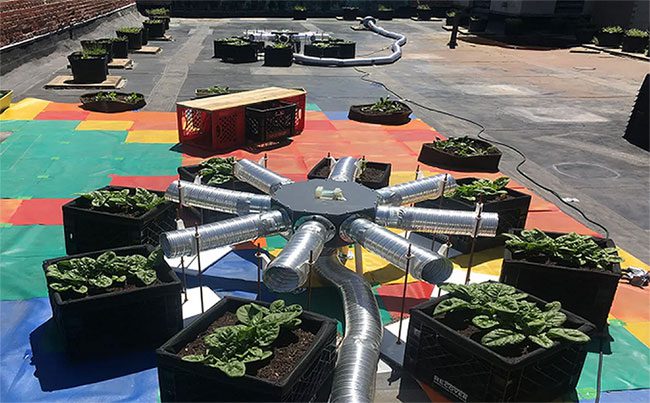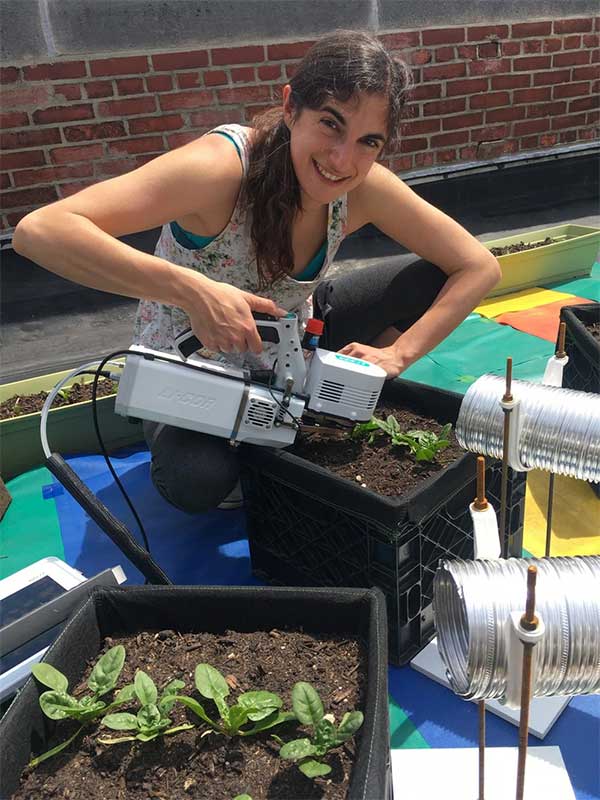The BIG GRO System (Building Integrated Greenhouse) is a solution for producing renewable energy and reusing CO2 from a building’s exhaust system to help rooftop gardens thrive.
The primary author of the research on the BIG GRO system is Dr. Sarabeth Buckley from the University of Cambridge. She believes that plants use CO2 as a food source, and when exposed to higher levels of CO2, they can grow faster than usual.
Dr. Buckley and her team used BIG GRO to grow spinach and corn on the rooftop of a building on the Boston University campus. They found that when plants were exposed to high concentrations of CO2, they grew larger and healthier.
“I planted the crops at the end of a building’s exhaust system on the rooftop to provide them with excess CO2,” Dr. Sarabeth Buckley stated.
CO2 Provides Nutrients

Rooftop gardening offers various ecological and financial benefits.
According to the United States Environmental Protection Agency (EPA), rooftop gardening provides several ecological and financial advantages. Rooftop gardens improve air quality in the area, reduce the building’s carbon emissions, and act as insulation while enhancing water quality.
However, managing rooftop gardens is challenging due to various obstacles that rooftop plants face. Direct exposure to sunlight, rainfall, and wind all affect their growth.
Most plants die or fail to thrive. Furthermore, setting up a rooftop garden with adequate water and nutrients for the plants comes with its own set of challenges.
In their search for solutions, researchers recognized that a supply of CO2 could benefit crops in rooftop gardens. CO2 is essentially food for plants, capable of enhancing photosynthesis, and is prevalent in urban environments due to dense human populations. It can boost plant growth, making rooftop gardens more effective.
To test this theory, the researchers decided to grow spinach and corn by placing them near a CO2 exhaust pipe on a rooftop. They created a rooftop garden using various equipment and technologies, naming it BIG GRO.
While explaining the different aspects of BIG GRO, Dr. Buckley noted: “I experimented with various application systems, but ultimately used a relatively simple aluminum duct to channel the exhaust towards the plants. I also employed milk crates lined with felt to grow all types of crops. This is the primary method used in rooftop farms in Boston.”
To monitor environmental conditions, Dr. Buckley used HOBO data loggers attached to vents and fans to record parameters such as CO2 concentration, temperature, and relative humidity every five minutes. Scientists found that the CO2 concentration in the air exiting the vent was more than sufficient to support healthy plant growth.
The research team also planted some spinach and corn near controlled fans (away from the CO2 exhaust) to compare growth differences. The results of this experiment aligned with the researchers’ expectations. The corn and spinach located near the exhaust vent were 2 to 3 times larger than those planted near the controlled fans.
Additionally, wind speed plays a crucial role in plant growth. Therefore, in a system like BIG GRO, maintaining optimal wind levels alongside CO2 concentration is essential.
Rooftop Vegetable Gardens

BIG GRO can create a more plant-friendly environment on rooftops.
According to Dr. Buckley, BIG GRO can create a more plant-friendly environment on rooftops, allowing for better growth and making rooftop gardens a more viable option for reducing cooling costs for buildings.
This leads to an increased installation of rooftop farms, providing various benefits ranging from temperature management to energy savings and overall quality of life improvements.
However, the BIG GRO exhaust application system needs optimization before it can become a mainstream and viable technology. During the research, scientists only planted crops directly around the exhaust vent, but ideally, people should be able to grow plants at a greater distance from the vent while still receiving similar benefits.
Moreover, they also need to test the effectiveness of BIG GRO on different types of plants and in various rooftop contexts. Dr. Buckley plans to further test and develop BIG GRO in New York. She aims to help increase yields in existing rooftop gardens and the overall number of rooftop gardens in the city.


















































